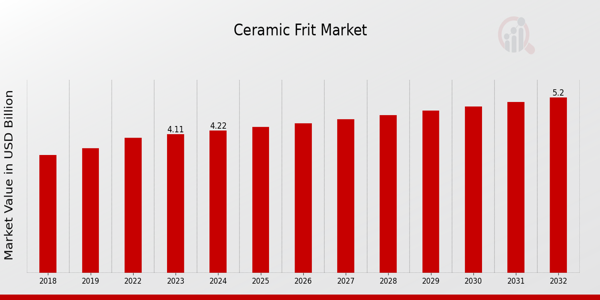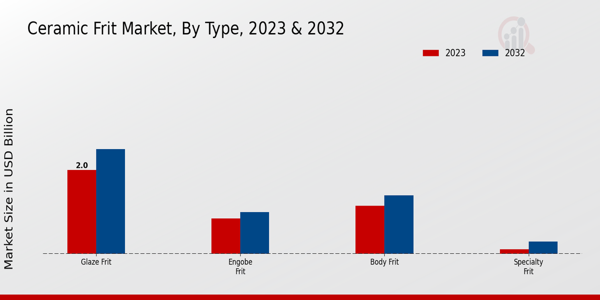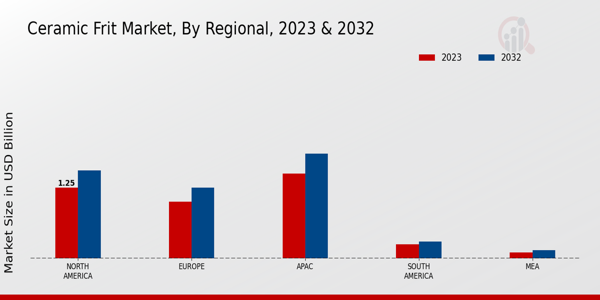Global Ceramic Frit Market Overview
The Ceramic Frit Market Size was estimated at 4.33(USD Billion) in 2024. The Ceramic Frit Industry is expected to grow from 4.44(USD Billion) in 2025 to 5.62(USD Billion) by 2034. The Ceramic Frit Market CAGR (growth rate) is expected to be around 2.70% during the forecast period (2025 - 2034).
Key Ceramic Frit Market Trends Highlighted
The Ceramic Frit Market is shaped by several key market drivers, including the growing demand for ceramic products in construction and home decor, as well as advancements in manufacturing technology that enhance the quality and appeal of ceramic materials. Increased urbanization and infrastructure development are propelling the need for innovative ceramic solutions, leading to a rise in production capacities and techniques. Furthermore, the trend toward sustainability in manufacturing processes is prompting ceramic producers to adopt eco-friendly practices, which aligns with the evolving consumer preferences for sustainable materials. Opportunities to be explored in the Ceramic Frit Market include the expansion of applications across various sectors such as automotive, electronics, and healthcare.The emergence of new technologies, such as digital printing and 3D printing, is paving the way for creative designs and applications of ceramic frit. Additionally, growing investments in green construction practices are highlighting the potential for ceramic materials that offer improved durability and aesthetic value, making them attractive options for builders and architects alike. Recent trends indicate a shift towards customized products that cater to specific consumer needs and preferences. The focus on aesthetic appeal and functionality in ceramic products is driving innovations in frit compositions as manufacturers seek to create unique textures and finishes.As the market evolves, collaboration between manufacturers and designers is fostering creativity, leading to new product lines that redefine traditional ceramic uses. Overall, these changes are setting a dynamic landscape for the Ceramic Frit Market, encouraging growth and innovation as it adapts to meet modern demands.
Source: Primary Research, Secondary Research, MRFR Database and Analyst Review
Ceramic Frit Market Drivers
Growing Demand for Advanced Ceramics
One of the major market drivers contributing to the growth of the Ceramic Frit Market Industry is the increasing demand for advanced ceramics across various domains, particularly in the construction, automotive, and electronics sectors. Advanced ceramics offer unique properties, such as high durability, thermal stability, and excellent electrical insulation, making them essential in high-performance applications. The trend towards using advanced ceramics in the manufacturing of tiles, sanitaryware, and electronic components is helping to fuel the growth of ceramic frit products.Furthermore, innovations in ceramic materials and coatings are driving manufacturers to seek ceramic frit that enhances the aesthetic and functional properties of their end products. As industries strive for more sustainable and efficient materials, the transition to advanced ceramics is steadily escalating, indicating a promising trajectory for the Ceramic Frit Market Industry. From energy-efficient building materials to components in electric vehicles, the versatility of ceramic frit makes it a critical component in supporting these advancements, thus propelling market growth sustainably and significantly.
Increasing Urbanization and Infrastructure Development
Urbanization and rapid infrastructure development in various regions are major drivers for the Ceramic Frit Market Industry. As cities expand and populations grow, there is a heightened need for infrastructure projects, including residential buildings, commercial spaces, and public amenities. This leads to increased consumption of ceramic products, such as tiles and ceramics used in construction. The demand for aesthetically pleasing and functional materials encourages builders and architects to incorporate ceramic frits, given their beneficial attributes, including durability and versatility.Moreover, investments in infrastructure are expected to rise globally, further boosting the ceramic frit demand as part of the construction materials.
Rising Consumer Preference for Aesthetic Appeal in Interiors
Another significant driver of the Ceramic Frit Market Industry is the increasing consumer preference for aesthetic appeal in interior design. Homeowners and designers are leaning towards stylish and trendy options that enhance the overall look and feel of spaces. Ceramic products, often finished with ceramic frit, emerge as popular choices due to their wide variety of colors, patterns, and finishes. The trend of personalization in home decor, where consumers seek unique and fashionable designs, stirs the demand for high-quality ceramic frit that allows for customization and creativity in ceramic products.This growing emphasis on design and aesthetics is likely to stimulate growth in the ceramic frit market.
Ceramic Frit Market Segment Insights
Ceramic Frit Market Type Insights
The Ceramic Frit Market is witnessing significant growth, particularly across its various types, which cater to diverse applications in the ceramics industry. The market revenue reached 4.11 USD Billion in 2023 and is projected to move towards a value of 5.2 USD Billion by 2032. Among the various types of ceramic frits, Glaze Frit occupies a preeminent position, with a robust valuation of 2.0 USD Billion in 2023, expected to rise to 2.5 USD Billion by 2032. Its dominance is attributed to its wide application in enhancing the aesthetics and functionality of ceramic surfaces, which makes it a preferred choice for manufacturers focusing on quality and design.Engobe Frit, valued at 0.85 USD Billion in 2023, is another essential type, expected to grow to 1.0 USD Billion by 2032. This segment plays a crucial role in providing colored coatings and enhancing the visual appeal of ceramics. Its strategic importance lies in the ability to create visually appealing products, making it increasingly relevant in a competitive market where design differentiation is pivotal. Body Frit, with a valuation of 1.15 USD Billion in 2023 and projected to reach 1.4 USD Billion by 2032, is significant as it is primarily used to improve the strength and durability of ceramic products. The structural integrity provided by Body Frit makes it a vital component in the production of high-quality ceramics, thus contributing significantly to overall market growth.On the other hand, Specialty Frit, with a relatively smaller valuation of 0.11 USD Billion in 2023, is anticipated to increase to 0.3 USD Billion by 2032. Although it holds a minority position in terms of market share, Specialty fit is important due to its unique applications, which cater to niche markets requiring specific functionalities and characteristics in their ceramic products. This segment exemplifies the ongoing trend towards specialization in manufacturing processes, addressing unique consumer demands and preferences.The ongoing trends within the Ceramic Frit Market highlight a growing emphasis on sustainability, innovation, and technological advancements, which are likely to drive future developments. With increasing awareness surrounding eco-friendly products, manufacturers are likely to explore options that reduce environmental impact while maintaining product quality. Additionally, advances in material science are leading to the development of advanced frit formulations that enhance the performance of ceramic products. As a result, the competitive landscape will continue to evolve, with a focus on these key drivers shaping the Ceramic Frit Market statistics and segmentation dynamics, ultimately creating a synergistic effect across all types. The combination of stronger competition and an expanding range of applications will contribute to the market's robustness moving forward.
Source: Primary Research, Secondary Research, MRFR Database and Analyst Review
Ceramic Frit Market Application Insights
The Ceramic Frit Market, valued at 4.11 billion USD in 2023, showcases diverse applications across key sectors like Ceramic Tiles, Sanitaryware, Tableware, and Electrical Insulators. Within the Application segment, Ceramic Tiles hold a significant position, driven by the booming construction and renovation activities globally, catering to both aesthetic and functional demands. Sanitaryware also plays a major role, influenced by the rising focus on hygiene and modern bathroom solutions, which contribute to the market's expansion. Tableware remains prominent as consumer preferences shift towards ceramic options for durability and design in kitchenware.Electrical Insulators, while less visible, are vital for industrial applications, particularly in the electrical sector, ensuring safety and efficiency. The Ceramic Frit Market segmentation reflects these dynamics, presenting opportunities amidst challenges such as raw material costs and technological advancements reshaping production methods. Overall, market growth is influenced by sustainability trends and increased demand for high-performance ceramic materials across these applications.
Ceramic Frit Market End-Use Insights
The Ceramic Frit Market, valued at 4.11 USD Billion in 2023, showcases a diverse range of applications across various end-use segments such as Residential, Commercial, and Industrial. The Residential sector holds a prominent position, driven by increased construction activities and residential remodeling projects, leading to a steady demand for ceramic products that enhance aesthetic appeal and durability. The Commercial segment also plays a significant role, fueled by the expansion of retail spaces, hospitality, and public infrastructure, necessitating high-quality ceramic frits for flooring, wall tiles, and decorative elements.Additionally, the Industrial segment is characterized by its essential applications in manufacturing processes, where ceramic frits are crucial for producing functional and decorative coatings. As these segments collectively contribute to the market growth, it is evident that the increasing urbanization and infrastructural developments globally are key drivers behind the escalating demand for ceramic frit applications, indicating a robust trajectory for the Ceramic Frit Market revenue in the coming years.
Ceramic Frit Market Form Insights
The Form segment of the Ceramic Frit Market plays a crucial role in facilitating various applications across industries. In 2023, the overall market was valued at 4.11 billion USD, reflecting its expansive growth. This segment includes diverse forms such as Powder, Granules, and Liquid, each catering to specific industrial needs. The Powder form is essential for applications involving fine-milled ceramic coatings and glazes, consistently holding a significant market share due to its versatile usage. Granules provide ease of handling and effective performance in processes like glazing in the ceramics industry, contributing to their dominance.Liquid forms, on the other hand, are gaining traction due to their efficiency in application, especially in high-demand areas like decorative ceramics. The Ceramic Frit Market statistics reveal the importance of understanding these segments to navigate challenges, capitalize on emerging opportunities, and follow market trends effectively. Overall, the Form segment demonstrates essential characteristics that are vital in shaping the dynamic landscape of the Ceramic Frit Market industry.
Ceramic Frit Market Regional Insights
The Ceramic Frit Market is predicted to showcase an expanding landscape across various regional segments, with a total market valuation of 4.11 USD Billion in 2023. North America holds a significant position at 1.25 USD Billion, expected to rise to 1.55 USD Billion by 2032, indicating its major holding in the market primarily due to the advanced manufacturing capabilities and strong demand for ceramic materials. Europe follows closely, characterized by a market value of 1.0 USD Billion in 2023, anticipated to grow to 1.25 USD Billion, reflecting stability and a strong inclination towards innovative ceramic applications.The APAC region leads the charge with a valuation of 1.5 USD Billion in 2023, growing to 1.85 USD Billion, demonstrating robust industrial growth and increased adoption of ceramic frit in various sectors. South America and MEA regions present smaller market sizes at 0.25 USD Billion and 0.11 USD Billion in 2023, respectively. These regions display potential growth opportunities driven by emerging markets and increasing investment in construction and decor. Overall, the regional segmentation reflects distinct market dynamics that influence the trajectory of the Ceramic Frit Market revenue, showcasing unique growth drivers and challenges in each region. 
Source: Primary Research, Secondary Research, MRFR Database and Analyst Review
Ceramic Frit Market Key Players and Competitive Insights
The Ceramic Frit Market is characterized by a variety of competitive dynamics driven by factors such as technological advancements, product innovation, and evolving consumer preferences. As companies seek to enhance their market share, they focus on differentiating their offerings and optimizing their production processes. The growing demand for ceramic frit in applications such as tile, glass, and other ceramics has led to an increase in market participants and strategic partnerships aimed at improving distribution networks and expanding geographic reach. The competitive landscape is further shaped by the necessity for sustainability and environmentally friendly production techniques, compelling companies to adapt and innovate in order to meet regulatory standards and customer expectations.Ferro Corporation stands as a notable player within the Ceramic Frit Market, leveraging its strong reputation for high-quality specialty materials. With a robust portfolio that includes innovative ceramic frit products, Ferro Corporation has established a significant market presence known for its commitment to research and development. This focus enables the firm to remain at the forefront of technological advancements, allowing for the customization of its offerings to better serve diverse customer needs. Additionally, Ferro Corporation's strategic partnerships with key industry players further reinforce its competitive edge by expanding distribution capabilities and enhancing product development, thereby contributing to its strong position in the ceramic frit sector.In the realm of the Ceramic Frit Market, CoorsTek is recognized for its extensive experience and innovative approach to manufacturing advanced ceramics. The company utilizes cutting-edge technology and rigorous quality control processes to produce high-performance ceramic frit products that meet the industry's demanding standards. CoorsTek's emphasis on research and improvement reflects its ongoing commitment to delivering superior solutions, which enhances its reputation among clients. Furthermore, CoorsTek's growing investment in sustainability practices aligns with current market trends, addressing the increasing consumer demand for environmentally responsible products. This strategy not only enhances its market competitiveness but also positions CoorsTek as a forward-thinking leader capable of responding to the evolving needs of the ceramic industry.
Key Companies in the Ceramic Frit Market Include
Ceramic Frit Market Industry Developments
The Ceramic Frit Market has recently witnessed several noteworthy developments. Ferro Corporation has made strides in advancing eco-friendly ceramic frit products, aiming to meet increasing sustainability demands. CoorsTek continues to invest in R&D for thermal and electrical ceramics, enhancing their frit offerings. In the dynamic landscape, SABIC is exploring innovative materials to diversify its product line, while Gerard Daniel Worldwide focuses on capacity expansion to meet rising consumer demand. Notably, Triton Minerals Limited and Nippon Paint Holdings are expanding their market presence by integrating ceramic frit applications into their products, thereby broadening their market reach. In mergers and acquisitions, it has been noted that Huntsman Corporation is considering strategic partnerships to strengthen its position in the ceramic materials sector. Moreover, the market's valuation is experiencing growth due to increased demand from industries such as construction and automotive, which in turn is likely influencing the investment strategies of major players like Dow Chemical Company and Mitsubishi Materials Corporation. The rise of new technologies and ongoing sustainability initiatives play a critical role in shaping the future trajectory of the Ceramic Frit Market.
Ceramic Frit Market Segmentation Insights
Ceramic Frit Market Type Outlook
-
Glaze Frit
-
Engobe Frit
-
Body Frit
-
Specialty Frit
Ceramic Frit Market Application Outlook
-
Ceramic Tiles
-
Sanitaryware
-
Tableware
-
Electrical Insulators
Ceramic Frit Market End Use Outlook
-
Residential
-
Commercial
-
Industrial
Ceramic Frit Market Form Outlook
Ceramic Frit Market Regional Outlook
-
North America
-
Europe
-
South America
-
Asia Pacific
-
Middle East and Africa
| Report Attribute/Metric |
Details |
| Market Size 2024 |
4.33(USD Billion) |
| Market Size 2025 |
4.44(USD Billion) |
| Market Size 2034 |
5.62(USD Billion) |
| Compound Annual Growth Rate (CAGR) |
2.70% (2025 - 2034) |
| Report Coverage |
Revenue Forecast, Competitive Landscape, Growth Factors, and Trends |
| Base Year |
2024 |
| Market Forecast Period |
2025 - 2034 |
| Historical Data |
2020 - 2024 |
| Market Forecast Units |
USD Billion |
| Key Companies Profiled |
Ferro Corporation, CoorsTek, SABIC, Gerard Daniel Worldwide, Minspar, Triton Minerals Limited, Nippon Paint Holdings, Huntsman Corporation, Dow Chemical Company, Krafft Group, Pangborn Corporation, EsmalglassItaca, Saarstahl AG, MCC Corporation, Mitsubishi Materials Corporation |
| Segments Covered |
Type, Application, End Use, Form, Regional |
| Key Market Opportunities |
Rising demand in construction sector, Innovations in eco-friendly formulations, Expansion in emerging markets, Growing popularity of aesthetic ceramics, Technological advancements in production methods |
| Key Market Dynamics |
Increasing demand from the construction industry, Growing popularity of eco-friendly materials, Innovations in glazing technologies, Expansion in emerging markets, Rising preference for customized designs |
| Countries Covered |
North America, Europe, APAC, South America, MEA |
Frequently Asked Questions (FAQ) :
The Ceramic Frit Market is expected to be valued at 5.62 USD Billion by the year 2034.
The expected CAGR for the Ceramic Frit Market from 2025 to 2034 is 2.70%.
The Glaze Frit segment is projected to have the highest value, expected to reach 2.5 USD Billion in 2032.
The North American Ceramic Frit Market is expected to be valued at 1.55 USD Billion in 2032.
Major players include Ferro Corporation, CoorsTek, SABIC, and Huntsman Corporation, among others.
The Body Frit segment is valued at 1.15 USD Billion in the year 2023.
The Specialty Frit segment is expected to reach a value of 0.3 USD Billion in 2032.
The European Ceramic Frit Market is projected to grow to 1.25 USD Billion by 2032.
Key growth drivers include increasing applications in the construction and automotive industries.
The APAC region is expected to be valued at 1.85 USD Billion in 2032.

















